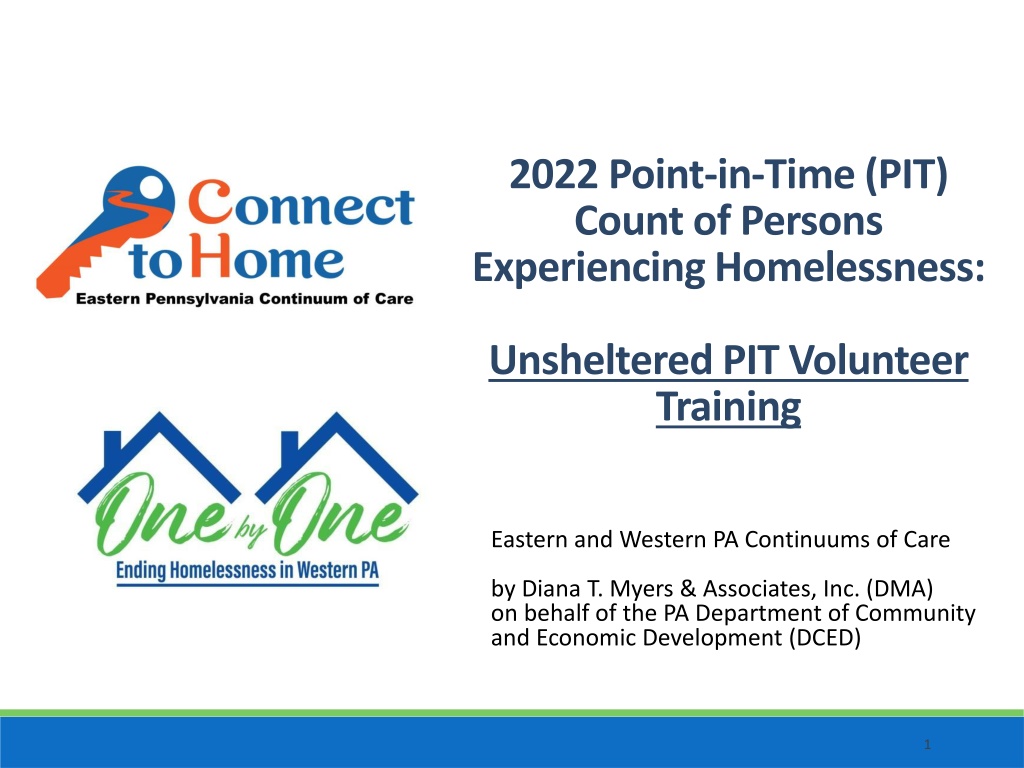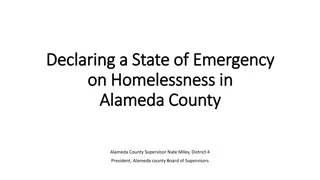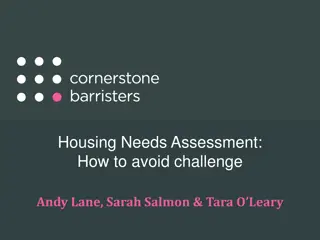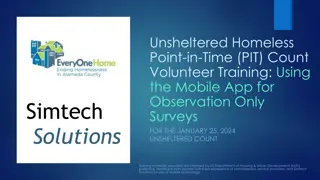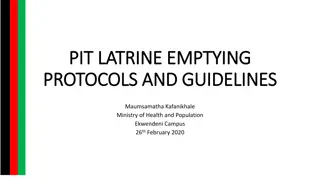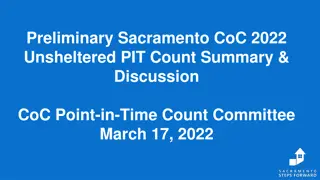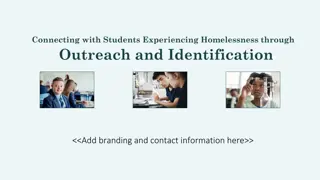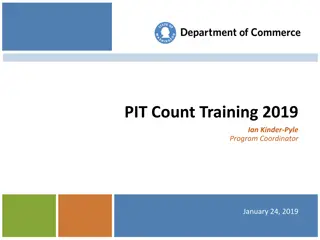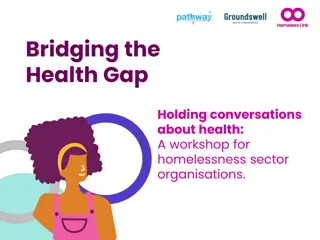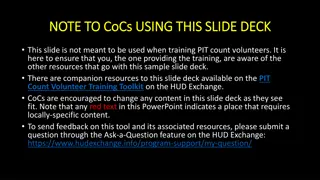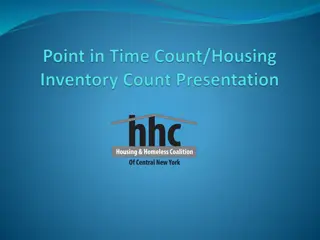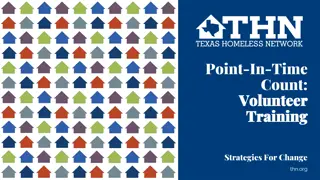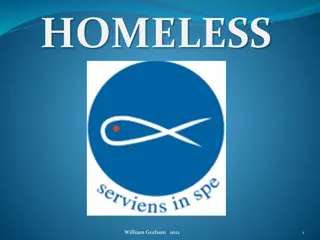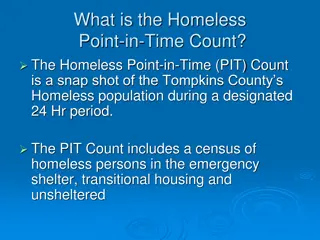Understanding the 2022 Point-in-Time (PIT) Count of Persons Experiencing Homelessness
Learn about the significance of the annual Point-in-Time Count (PIT) conducted to measure homelessness trends, the distinction between sheltered and unsheltered counts, the guiding principles of the count, its purpose, and the specific locations where unsheltered individuals may be found. Explore why this count is crucial for communities and how it aids in allocating resources effectively to combat homelessness.
Download Presentation

Please find below an Image/Link to download the presentation.
The content on the website is provided AS IS for your information and personal use only. It may not be sold, licensed, or shared on other websites without obtaining consent from the author. Download presentation by click this link. If you encounter any issues during the download, it is possible that the publisher has removed the file from their server.
E N D
Presentation Transcript
2022 Point-in-Time (PIT) Count of Persons Experiencing Homelessness: Unsheltered PIT Volunteer Training Eastern and Western PA Continuums of Care by Diana T. Myers & Associates, Inc. (DMA) on behalf of the PA Department of Community and Economic Development (DCED) 1
Point-in-Time (PIT) = a snapshot of the number of people experiencing homelessness on a given night Includes people sleeping in: What is the PIT count? SHELTERED locations. This can include emergency shelters, domestic violence shelters, sometimes motels, transitional housing UNSHELTERED locations. You will count people experiencing homelessness in UNSHELTERED locations Required by HUD nationally during last 10 days of January* (note: HUD allowed CoCs to postpone to February in 2022 due to COVID-19) 2
What is the unsheltered count? What does UNSHELTERED mean? Individuals or families whose primary nighttime residence is a public place not meant for human habitation What does COUNT mean? Obtaining basic demographic information on each person and household
Why do we do a PIT count? To measure and monitor trends and changes in homelessness on local and national levels To help our community understand what resources we need and strategize the best ways to use them to end homelessness To comply with federal regulations and requirements 4
2022 Unsheltered PIT Count Date: Wednesday, February 23, 2022 This refers to the overnight hours on Wednesday evening Feb. 23rd through Thursday morning Feb. 24th. When is the PIT count conducted? NOTE: The date cannot be changed by one county or RHAB. The entire CoC must conduct the count on the same date.
Unsheltered Count: Guiding Principles Safety Anonymity Each person counted Each person counted once 6
Unsheltered Count - Locations Where will we find families and individuals who are experiencing homelessness? You will be assigned to a particular area of the county where you will seek people staying in the following types of places: Streets Vehicles Parks Hunting cabins Tents Campgrounds Barns Truck Stops Abandoned buildings Transportation depots Chicken coops Railroad cars Storage units Lumberyards 7
Unsheltered Count - Locations Where will we find families and individuals who are experiencing homelessness? Some counties utilize a service-based count, where volunteers go to locations such as soup kitchens, community centers, etc. to identify and survey persons experiencing homelessness. 8
Unsheltered Count: Locations Unsheltered Count DOES NOT include individuals living in these locations: Hotels/motels not funded through public/ charitable resources Shelters, transitional, or permanent homeless programs Jails/prison Emergency rooms/ hospitals Halfway houses Recovery houses Residential/medical facilities Youth in custody of state in foster care or other out-of-home placement Doubled up in the homes of family/friends 9
Unsheltered Count Who? All household types are included: Households with children Households without children Couples- married and unmarried Single individuals Other makeups where the persons define themselves as a household (intergenerational households of adults, siblings, etc.) and there are no children Youth unaccompanied children < age 18 unaccompanied youth, 18-24 parenting youth 10
Unsheltered Count How? Unsheltered PIT surveys are conducted either via: Brief Interviews Observation Only 11
Unsheltered Count How? 1. Brief interviews preferred Complete one Interview Form for each household If a household has more than five members please record additional data on a second form, clearly indicating that they are part of same household If a household includes more than one person, please ensure that data is recorded on the form consistently recording the data based on the assigned person # . e.g. If LH is person # 1 and BH is person # 2 on page 2, please ensure that BH is also person # 2 on the subsequent pages. 12
Unsheltered Count How? 2. Observation - If someone will not or cannot provide the information requested on the Interview Form, complete the observation only section at end of survey based on your observation. It is very important that you fill out the entire section. 13
Completing the survey form 14
Survey Forms: Before beginning Write your county name at the top left. Please write your name or team name/number on the top right of the form, along with the date/time of count. 15
Survey Forms: Introduction Hello, I am (introduce yourself by your first name). We are conducting a survey to count people experiencing homelessness in order to learn more about people experiencing homelessness, what kinds of problems they face, and to better understand what services are needed to address homelessness. Your participation is voluntary and your response to each question is voluntary. I will ask for your initials and your date of birth, but I will not need your name, social security number, or any other information that could be traced back to you. The responses to these questions will not be shared with anyone outside of our team. I will need to read each question all the way through. Note: This script is also on the interview forms. 16
Survey Forms: Consent & Screening Can I have 10 minutes of your time? If no, and you believe this individual/ household is sleeping in an unsheltered location, please discontinue the survey and instead complete the observation information at end of survey. If individual is asleep, please proceed to observation section. Did another volunteer or survey worker already ask you questions about where you are sleeping the night of Jan. 26th (insert: tonight or last night)? If yes, please discontinue the survey. No further information is needed. 17
Brief Surveys: What information are we collecting? o Number of persons in household o For each person in household: o Age o Ethnicity o Gender o Race o Additional data collected for adults or youth under 18 who are head of household: o Number of homeless episodes and length of time homeless o Domestic violence status (not asked in front of two adults who have identified that they are part of the same household) o Veteran status o Disability information 19
Brief Survey: Where did you sleep? Where are you sleeping/did you sleep the night of Jan. 26th? Households in the locations above will be included in the unsheltered PIT count. 20
Brief Survey: Where did you sleep? In addition to checking off the appropriate unsheltered location, please write down any details about location. This information is used to ensure a household is not double counted. Please provide as much identifying information as possible. e.g. Blue tent behind Walmart in Pennsylvaniatown; sleeping in brown van in Flying J Truck Stop in Centralville 21
Brief Survey: Where did you sleep? Emergency Shelter. Households in emergency shelters will be counted in the sheltered PIT count. If you transport a household to shelter, please coordinate how the information on this Interview Form will be collected, on the Unsheltered Interview Form or by the Shelter. In a hotel/motel/rent-a-room: If yes, who paid for the room? If a household is sleeping in a hotel room on 1/26/22 that is paid for by government/non-profit, they should be included in the sheltered PIT count. Programs that provide hotel vouchers are included in the sheltered PIT count. If you encounter someone sleeping in a hotel on the PIT night and they have not yet completed an interview form, please complete the interview. If you provide transportation to a hotel and/or hotel vouchers during your unsheltered PIT count, please complete this Interview Form. Other. Specify: Depending on the location, this household may or may not count in the unsheltered or sheltered PIT count. In the home of a family member or friend PLEASE CHECK OFF, SAY THANK YOU & DISCONTINUE THE SURVEY In a home that I own/rent PLEASE CHECK OFF, SAY THANK YOU & DISCONTINUE THE SURVEY 22
Brief Survey Questions If you identify that the household is unsheltered, please complete the remaining questions. Inform participants participation is voluntary. Individuals may refuse to answer some or all questions. Information is self-report: please do not assume any information. 23
Brief Survey Questions Initials only, no name. If person refuses to give initials, assign initials and complete rest of interview. Age If a person does not wish to share, please estimate age range. Gender, ethnicity, and race Read the lists out loud and have the person self-identify their response. Please do not assume a response 24
Brief Survey Questions Ask all questions as written on the Interview Form or within the Mobile App. Demographic questions should be asked of all household members. Domestic violence and additional questions should be asked only of adults or youth under 18 who are head of household (note: these instructions are on the form). Domestic violence questions should not be asked if two adults are being interviewed together (note: these instructions are on the form). 25
Unsheltered Count Observation Only Observation Only Section 27
Unsheltered Count: Observation Only When to conduct count by observation only Individual/household is asleep/bedded down (need to write this on the form) Individual/household is unwilling to be interviewed/complete the full interview, but you believe them to be experiencing homelessness (need to write the details on the form). E.g., on a park bench outside in winter with all of their belongings E.g., the individual is known to you and your team 28
Write down as much detail as possible that helps to make the person identifiable and to provide clues on their housing status. What is the person wearing? (e.g., black beanie, navy sweatshirt, jeans, and tan utility boots. or bundled in a grey, puffy sleeping bag that covered their face. ) What does the person look like? (e.g., shoulder-length grey hair, white, female, 50-60 years old ) Why were you unable to complete a survey with them? (e.g., They said they did not want to complete a survey, but they were awake. ) Where did you see them? (e.g., In front of the TD bank at the corner of 6thand Cedar St. What makes you think that they are or may be experiencing homelessness? (e.g., They were sleeping on a park bench with a large bag of their belongings next to them. ) Unsheltered Count: Observation Only 29
When is an observational survey NOT appropriate? I saw a man in a red sweatshirt riding by on a bike by that looked homeless. Dunkin Donuts said there is a man who hangs out sometimes who is homeless. Unsheltered Count: Observation Only Why not appropriate? Not enough detail (age, appearance, location, details of why you believe they are experiencing homelessness) If we have more information, the unsheltered coordinator can work to make sure they were not counted by another team or an emergency shelter Third party reports are not appropriate to include in the PIT count. The person must be counted/observed by your team. 30
Your Role After the Interview Record what you heard and observed Walk away from the person interviewed to a safe place Take a few minutes after your conversation to double check that you ve completed the whole survey form Include any additional notes or details Make sure everything you have written is readable Please turn all forms in to your county unsheltered PIT coordinator at the conclusion of the count. If your county is using the PIT mobile app, surveys will be submitted automatically as they are completed. 31
Walk through PIT survey form 32
Best Practices and Safety Considerations 33
Best Practices Keep in mind: Individuals sleeping outside may be dealing with active addiction, mental health concerns, and significant trauma histories. Do not sneak up on or startle people. Never shine flashlights in people s faces. Maintain eye contact (if possible) and an open stance with your hands visible. Use a tone of voice that s approachable. Speak slowly, be polite, and don t shout. 34
Best Practices Remember that you are speaking to highly vulnerable people. Always lead with respect for the person you re speaking with and respect for their dignity. Everyone has the right to refuse to answer any or all of your questions. Ask all questions, unless the person has already given the answer to the question over the course of your conversation. Always ask questions as they are written; do not ask questions in a way that shows you think you already know the answer. 35
Considerations for Domestic Violence Survivors If you identify someone who is fleeing DV or identifies as a domestic violence survivor during the PIT Count: If the survivor is interested, refer to local DV program for safety planning assistance PIT volunteers are not expected to safety plan, but if engaged, listen to the survivor and ask what they need What has worked for you to stay safe in the past? What do you need to stay safe tonight? Tomorrow? 36
Considerations for Domestic Violence Survivors Make sure the survivor knows that all collected information from the PIT count is non-identifiable Make sure the survivor knows that you will not share their disclosure and/or story with anyone, other than submitting non-identifiable data If a survivor feels uncomfortable sharing, don t press for information 37
Safety Considerations The safety of all PIT count volunteers is of highest priority. Please do not enter a situation that is unsafe. This may include: Building that is not structurally sound. Traveling down unpaved/ snow covered roads unless you are in a car that can handle those conditions. Approaching an individual or group of people if it does not feel safe. Volunteers should always go out in teams (should never conduct interviews or observations alone). 38
COVID-19 Safety Considerations PPE CoCs conducting counts will need to ensure that all volunteers have some PPE. CoCs will ask all volunteers to bring masks and wear them for the duration of the count. Social distancing CoCs will need to conduct counts in compliance with social distancing principles which recommends remaining at least 6 feet apart. CoCs should create small counting teams, with only two or three volunteers per team. These teams should maintain at least six feet from one another other as well as people experiencing homelessness whenever possible. 39
COVID-19 Safety Considerations Testing/symptom checks If possible, volunteers should be tested for COVID-19 prior to participation in the count no more than 7 days prior, or at least screen for symptoms and check temperatures. Volunteers should stay home if they have any symptoms. Volunteers should observe for symptoms for up to 14 days after the count and consider getting tested for COVID-19. Other Your county coordinator will review any other COVID-19 safety related considerations with you. 40
Next Steps 41
Items to review with your county unsheltered PIT coordinator: Schedule Key Contacts Safety Protocols What to bring Method for submitting surveys Any other questions you have Logistics 42
Additional Resources: If you would like additional resources on the Point in Time Count: How to approach an individual on the street training video: https://www.homelessnesslearninghub.ca/library/resources /how-approach-individual-street-video HUD sample handout with tips and resources for volunteers conducting the PIT Count: https://files.hudexchange.info/resources/documents/PIT- Count-Volunteer-Training-Toolkit-Sample-Refresher- Handout.docx 43
FINALLY... THANK YOU for Giving your time Caring Helping Showing up! THANK YOU FOR BEING PART OF THE 2022 UNSHELTERED PIT COUNT! 44
